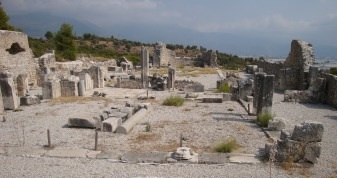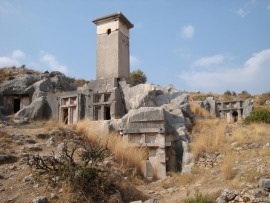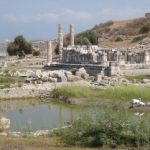“Cynical Town” Population (Kınık): 13,400
The beautiful ruins of the Lycian city of Xanthos are a one km walk uphill from the main road at Kınık, between Fethiye and Patara. The site forms one of Turkey’s UNESCO-listed world heritage sites along with the nearby Letoon to which it was linked by a sacred way. It is the most complete Lycian city to have survived and has also provided the most informative inscriptions in the Lycian language.
Backstory
Dating back to around the 8th century BC, Xanthos became a hugely important town, the capital of Lycia and its largest city, with fine monumental buildings to show for it.
The city was also more than usually determined to keep its independence, so much so in fact that in 540 BC when it was staring defeat in the face at the hands of the Persian general, Harpagus, the women and children immolated themselves on funeral pyres while their men went down fighting (other accounts suggest that the men murdered the women and children before throwing themselves into fruitless battle). In 42 BC as the Roman general Brutus descended on them the locals once again preferred to kill themselves rather than surrender.
The site continued in occupation into the Byzantine period, as evidenced by the remains of a basilican church.
Around the site
As you approach the acropolis of Xanthos you pass on the lefthand side of the road a crumbling arched gateway. On the other side of the road are the scant remains of the early 4th-century BC Nereid Monument whose statuery is now in the British Museum.
Continuing up the road you come to the remarkably well-preserved theatre as well as to two soaring monuments. One resembles a raised Lycian tomb while the other, the so-called Harpy Tomb, is a 5th-century BC Persian-style building with a flat roof beneath which can be seen copies of carvings carted off to England via the port at Patara by the English archaeologist, Charles Fellows, in 1842. They too now reside in the British Museum. The “harpies” may in fact be unknown Lycian or even Greek deities.
In front of the theatre is an agora with a fine stone inscribed in the Lycian language. Behind it yet more ruins run out onto a headland above the Xanthos river, offering a panoramic view of the Kınık greenhouses.
 Across the road from the theatre is a long stretch of glistening white flagstoned road which leads eventually to the remains of a basilican church that must have been in its heyday as big and impressive as the one in Demre. You can still make out the carved marble entrances that led from the narthex into the body of the church as well as the synthronon ringing the apse. A cloister-like area stood in front of the church.
Across the road from the theatre is a long stretch of glistening white flagstoned road which leads eventually to the remains of a basilican church that must have been in its heyday as big and impressive as the one in Demre. You can still make out the carved marble entrances that led from the narthex into the body of the church as well as the synthronon ringing the apse. A cloister-like area stood in front of the church.
Behind the ticket office a path leads uphill to the necropolis where there are a mixture of sarcophagi and temple-style rock tombs as well as a second tall, flat-roofed monument like the one beside the theatre, this time without any carvings on it. Further uphill the path runs out but you’ll come to the ruins of a small castle.
If you follow the road up past the ticket office you will come eventually to a vast rockface pitted with yet more picturesque tombs.
Like Stonehenge, Xanthos is a little unlucky in its location since it has a road slicing through it. Were it not for the road the ticket office could be positioned at the foot of the hill, making it less obtrusive.
Sleeping
There’s nowhere to stay in Kınık. Most people visit from Fethiye, Patara, Kaş or Kalkan.
Transport info
Any of the dolmuşes plying the coast road from Kaş, Kalkan and Patara to Fethiye will be able to drop you off at Kınık whence the ruins are clearly signposted.
There are also tours to Xanthos and the Letoon from all the nearby resorts. They usually include other destinations as well.


